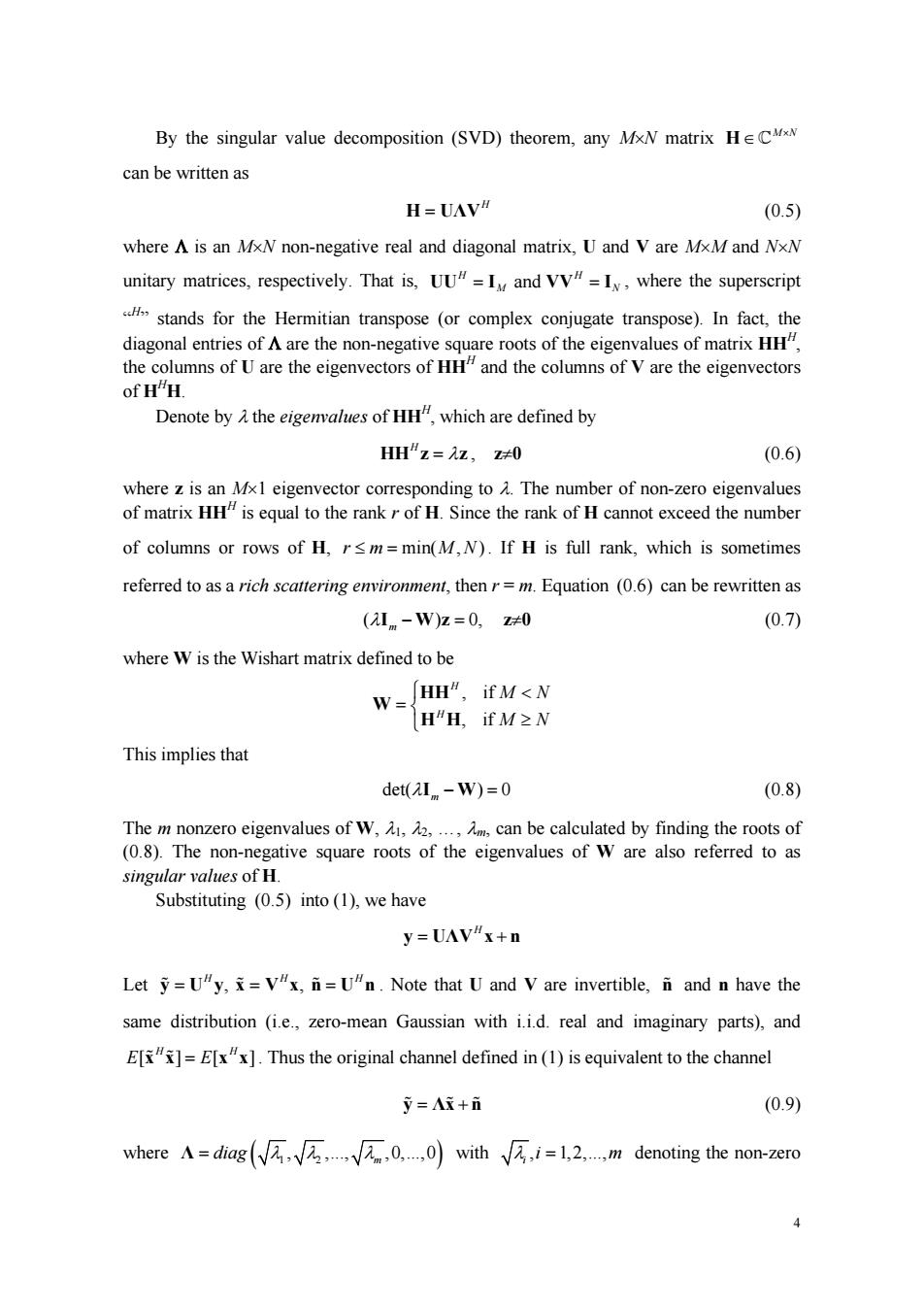正在加载图片...

By the singular value decomposition(SVD)theorem,any MxN matrix HC can be written as H=UAV (0.5) where A is an MxN non-negative real and diagonal matrix,U and V are MxM and NxN unitary matrices,respectively.That is,UU=I and VV#=I,where the superscript stands for the Hermitian transpose (or complex conjugate transpose).In fact,the diagonal entries of A are the non-negative square roots of the eigenvalues of matrix HH, the columns of U are the eigenvectors of HH and the columns of V are the eigenvectors of HH Denote bythe eigemalues of HH which are defined by HH“z=z,Z0 (0.6) where z is an Mxl eigenvector corresponding to The number of non-zero eigenvalues of matrixHH is equal to the rankrof H.Since the rank of H cannot exceed the number of columns or rows of H.rsm=min(M,N).If H is full rank,which is sometimes referred to as a rich scattering environment,then r=m.Equation (0.6)can be rewritten as (L.-W)z=0,z0 (0.7) where W is the Wishart matrix defined to be W=H"ifM<N HH,ifM≥N This implies that det(l -W)=0 (0.8) The m nonzero eigenvalues of W, .can be calculated by finding the roots of (0.8).The non-negative square roots of the eigenvalues of W are also referred to as singular values of H. Substituting (0.5)into(1).we have y=UAV"x+n Let y=U"y,=V"x,n=U"n.Note that U and V are invertible,n and n have the same distribution (i.e.,zero-mean Gaussian with i.i.d.real and imaginary parts),and E[=E[xx].Thus the original channel defined in(1)is equivalent to the channel y=A+ (0.9) where A=diag(V,√5,√,0,0)with√万,i=l2,denoting the non-zero 44 By the singular value decomposition (SVD) theorem, any M×N matrix M ×N H∈C can be written as H H U= ΛV (0.5) where Λ is an M×N non-negative real and diagonal matrix, U and V are M×M and N×N unitary matrices, respectively. That is, and H H UU I VV I = M = N , where the superscript “ H” stands for the Hermitian transpose (or complex conjugate transpose). In fact, the diagonal entries of Λ are the non-negative square roots of the eigenvalues of matrix HHH, the columns of U are the eigenvectors of HHH and the columns of V are the eigenvectors of HHH. Denote by λ the eigenvalues of HHH, which are defined by H HH z z = λ , z≠0 (0.6) where z is an M×1 eigenvector corresponding to λ. The number of non-zero eigenvalues of matrix HHH is equal to the rank r of H. Since the rank of H cannot exceed the number of columns or rows of H, min( , ) r m MN ≤ = . If H is full rank, which is sometimes referred to as a rich scattering environment, then r = m. Equation (0.6) can be rewritten as ( ) 0, λI Wz m − = z≠0 (0.7) where W is the Wishart matrix defined to be , if , if H H M N M N ⎧ < = ⎨ ⎩ ≥ HH W H H This implies that det( ) 0 λI W m − = (0.8) The m nonzero eigenvalues of W, λ1, λ2, ., λm, can be calculated by finding the roots of (0.8). The non-negative square roots of the eigenvalues of W are also referred to as singular values of H. Substituting (0.5) into (1), we have H y U= ΛVx n + Let , , HHH y === U y x Vxn Un . Note that U and V are invertible, n and n have the same distribution (i.e., zero-mean Gaussian with i.i.d. real and imaginary parts), and [][] H H E E xx xx = . Thus the original channel defined in (1) is equivalent to the channel y = Λx n + (0.9) where ( ) 1 2 , ,., ,0,.,0 m Λ = diag λλ λ with , 1,2,., i λ i m = denoting the non-zero